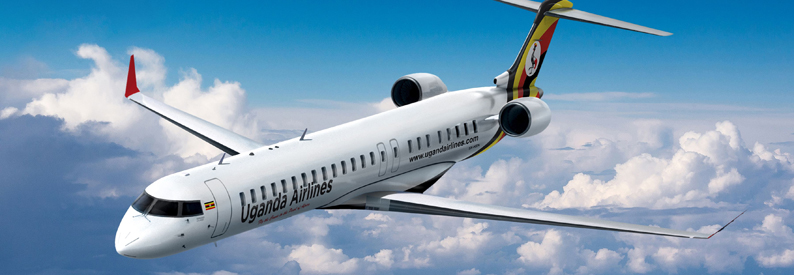Dissecting Uganda Airlines fleet strategy

Michael Wakabi
As the first pair of Uganda Airlines Bombardier CRJ-900 jets embarked on the last leg of their ferry flight to Entebbe, a section of social media has been abuzz with debate over why the carrier should launch with 76 seat aircraft, when its predecessor operated bigger jets. Some commentators went as far as comparing the aircraft to commuter buses.
To some degree, those sentiments reflect the questions that airline management teams have to grapple with as they configure fleets and choose aircraft types. Unlike potential passengers who will simply love a big bird, airlines have to crunch the numbers.
Just like fashion where the garment must fit the wearer for a positive overall outcome, in the airline business, the aircraft must fit the route. In effect, an aircraft will only operate a particular route economically and even profitably, if its size is aligned to the potential number of passengers on a particular route. Generally, aircraft are designed to achieve operating break even if they are flying with half the number of passengers they are designed to carry. In abnormal markets such as Entebbe-Nairobi where fares are high, an airline can achieve break-even with a cabin factor as low as just 30 percent.
So if on average 30-40 passengers’ travel between point A and point B on three days of the week but the number surges to 50-65 passengers on the other four days, an aircraft configured to 76 passengers is best suited to make the most of the low and peak days. Deploying a 100 seat aircraft on such a route would mean operating at a loss for three days of the week.
For a carrier like Uganda Airlines, whose initial network is going to be regional, the choice CRJ-900 makes a lot of sense. On routes such as Entebbe-Nairobi, only 30-35 percent of all the people who embark at Entebbe, terminate their journeys in Kenya. If there are 500 people departing Entebbe daily on that route, only 150 disembark in Kenya. This is the market that Uganda Airlines will be competing for. But that number is spread across several flights during the day by Kenya Airways.
Uganda Airlines therefore needs frequency – atleast three departures daily- in order to be close to the times at which these potential customers want to travel. One could deploy a 150 seat aircraft such as a Boeing 737-800 or Airbus A319 but that would mean herding them on to a single flight. It wouldn’t work. The CRJ-900 therefore best meets the requirement for trip economics as well as frequency.
On the other hand, you have routes such as Entebbe- Dares salaam where all traffic typically terminates in Tanzania. The CRJ-900 has the flexibility to operate those thin routes without burning a hole in the pocket.
The small capacity regional jet, pioneered by Bombardier when it put the 48 seat CRJ-100/200 into service 28 years ago, revolutionalised regional operations for airlines. Although it cost just $14 million back then, conservative airline managers in Africa continued to operate aged fuel guzzling 100+ seat Boeing 737’s on routes such as Entebbe-Bujumbura where you were lucky to pick even 20 point to point passengers. Besides other factors such as operating the wrong routes, this misapplication of equipment contributed in no small measure to the collapse of African airlines between 1990 and 2005.
Today Kenya Airways has turned the Embraer E series into its workhorse around the region. These jets seating between 72 and 100 passengers have allowed KQ to drive frequency in a manner that would not have been as feasible with the B737-800. Because of the inherent economics of its Embraer fleet, KQ is able to offer better connectivity through its Nairobi hub. A passenger does not have to wait longer than two hours at most between flights to Entebbe.
Airlines strive to find the sweet spot between capacity and demand. Too small an aircraft and you miss out on the cost advantages a big aircraft would deliver if there was enough demand. Too big an aircraft and you are exposed to the higher costs of operating a big bird two-thirds empty.
Bigger aircraft will make sense when Uganda Airlines graduates into a network carrier. That means it will not be taking people just around the region but will be able to consolidate traffic to key points beyond Eastern Africa. The regional network will create the feed that will fill the large cabins of the A330-800 when it arrives in twenty months’ time.
Configuration of an airline’s route network, is a process that is now informed by data. There are companies that aggregate passenger trip data from departure point down to final destination. For instance if 100 people leave Entebbe on Kenya Airways, where does each of them end up? By analyzing such data, a new player on the Entebbe-Nairobi route can see where the opportunity is and position themselves better to compete. If Uganda Airlines takes this approach to route development, ignores the political noise and contains costs, it has a very good chance of succeeding in the regional air transport market.
Michael Wakabi is a journalist with extensive experience reporting the African aviation scene. For several years he was one of three Africa based stringers for the UK based air transport weekly, Flight International.

 Standard Bank Group appoints new Chief Executive for Uganda Holdings
Standard Bank Group appoints new Chief Executive for Uganda Holdings
 TradeMark Africa introduces new App to limit EAC trade barriers
TradeMark Africa introduces new App to limit EAC trade barriers
 Employer hiring up during November as Stanbic PMI rises to 53.4
Employer hiring up during November as Stanbic PMI rises to 53.4
 Shell Club rewards first winners with brand new motorbikes in Mbale
Shell Club rewards first winners with brand new motorbikes in Mbale
 CSBAG roots for increased funding for renewable energy
CSBAG roots for increased funding for renewable energy
 Equity walks tried and tested path to deliver solid half-year
Equity walks tried and tested path to deliver solid half-year
